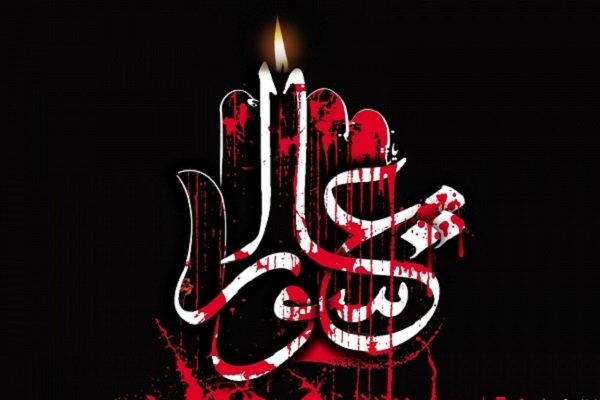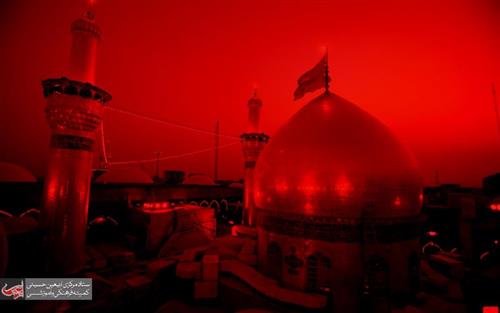
- Release Date: 2017/10/30
- View: 368
By Shervin Abdolhamidi, The spirit of Ashura.
The days of Muharram fill the air of Tehran, and Iran with a special atmosphere. The streets are covered in black flags and banners. Along the sidewalks, on the buses, on the metros, you see masses of people wearing black, honoring the Martyrs of Karbala and expressing their devotion and respect to Imam Hussein.
Throughout the months of Muharram and Safar, and especially the first ten days leading up to Ashura, a palpably forlorn vibe permeates here throughout all of Tehran and surely the rest of Iran. Every night this feeling of sadness and tragedy is signified as the air resonates with the sound of the eulogies and drums emanating all across the city, as people take to the streets to express their love for Imam Hussein (AS), and mourn and commemorate his sacrifices.
In Iran and other Shiite countries and communities the first ten days of the Islamic month of Muharram are marked with a period of mourning, where Shiites commemorate the heroic, selfless uprising and subsequent martyrdom of Imam Hussein, the grandson of the Prophet Mohammad, who rose up against the tyrant kalifate of the time Yazid in seventh-century Karbala. In what is regarded as one of the greatest historic epics of Shiite Muslim history, Imam Hussein and 72 of his willing, loyal followers were all martyred fighting outnumbered against an overwhelming army. For Muslims Ashura and Imam Hussein’s martyrdom is a lesson never to yield to a tyrant, and to stand up and resist, regardless of the repercussions.
The mourning ceremonies started as a way for Shiites to remember Imam Hussein and his lessons, which have been commemorated for centuries through mourning ceremonies and even reenactments of historical events leading to Tasuah, the ninth day of Muharram when Imam Hussein turned off all the candles at night and permitted everyone who is not ready for martyrdom to leave in the cover of darkness, and finally Ashura, the tenth day of the month of Muharram, when the last stand was made.
The ceremonies and rituals typically comprise of dasteh (mourning processions) which take to the streets and perform synchronized rituals of sineh-zani (beating one’s chest), or zanjir-zani (flagellating one’s back with a small chain) in harmony with the chanting of madahan (eulogists) who sing of the tragedies of Ashura and the sacrifices made by the martyrs.
Today, over 1400 years since that day, Shiites, and especially Iranians still hold the Muharram ceremonies with a passion and love that has not ebbed over the centuries. In the day leading up to Ashura, every day and every night there are mourning processions, grassroots events organized by people for the people.
amilies, give nazri (charity food), take their kids to learn about Imam Hussein, and more. Indeed, these days in Iran, the Days of Muharram have become a time for unity and harmony, where families gather together, to mourn Imam Hussein and also to bolster their family bond, which was so important for Him.
In these days, on the streets one sees a greater sense of peace among people, as each of us in Iran tries to improve ourselves, to become more like the men and women of Karbala. People tend to be kinder, more patient, and more generous, and overall become better Muslims and better human beings. The prevailing sentiment is that, if Imam Hussein and his followers endured all that he did, in the immaculate manner in which he did, then surely we can endure the adversities in our lives in the same manner, and with the same reliance on Allah, as Imam Hussein and his followers did.
Moreover, ceremonies and the stories of the tragedies of Karbala evoke a sobering sensation even in the hearts of those who do not participate, instilling within the hearts of even non-Muslims at the very least a profound respect for Imam Hussein. For the story of Karbala is one of a great human’s fight for justice, for humanity and for Islam; it is a story about the courage to rise up against tyranny and the unwavering will and belief to never yield to an evil, no matter the odds.
Indeed, Imam Hussein has inspired many of the modern world’s leaders and freedom fighters. As Mahatma Gandhi said, “I learned from Hussain how to be wronged and be a winner, I learnt from Hussain how to attain victory while being oppressed.”
Moreover, the venerable human rights activist, Nelson Mandela once said, “I have spent more than 20 years in prison, then on one night I decided to surrender by signing all the terms and conditions of government. But suddenly I thought about Imam Hussain and Karbala movement and Imam Hussain gave me strength to stand for right of freedom and liberation and I did.”
As the profound, moving days of Karbala come to an end, Iranians and Shiites around the world strive to maintain their spiritual growth during these days, and to become better people in all facets of their lives.
Imam Khomeini, the founder of the Islamic Republic of Iran aptly summarizes this, stating, “Every day is Ashura and every land is Karbala.”
Related News
Latest Articles
- The status of Aba al-Fadl al-Abbas(PBUH) in the heart of Lady Fatima az-Zahra(PBUH).
- The status of Aba al-Fadl al-Abbas in the heart of his mother Umm al-Baneen(PBUT).
- Between the two martyrs: al-Abbas and Ja'far (peace be upon both of them).
- The History of Libraries in Karbala
- Aba al-Fadl al-Abbas: ‘Bab ul-Hawaaij’ - the door to settlement of needs.
- The departure of the ambassador of Imam al-Hussayn (peace be upon him); Moslim Ibn 'Aqeel to Kufa.
Most Viewed Articles
- Antoine Bara: You Shi’a Do not Appreciate the Value of Imam Hussein!
- The Day of Arbaeen
- Biography of Ayatullah Haajj Sayyid Ali Khamenei
- True Colours: Saudi Arabia resorts to slander to tarnish both Iraq and Arbaeen by Catherine Shakdam
- The women of Karbala and Hussain’s message
- Whoever said that women are the weaker sex? By: Chris Hewer
- KARBALA AND BEYOND
- Letting freedom ring: How Islam’s universal message continues to speak through Imam Husayn ibn Ali
- Imam Hussain’s Revolution for Humanity by Marwa Osman
- The status of Aba al-Fadl al-Abbas in the heart of his mother Umm al-Baneen(PBUT).
- Aba al-Fadl al-Abbas(PBUH) the gate to Imam Aba Abdillah al-Hussayn(PBUH).



